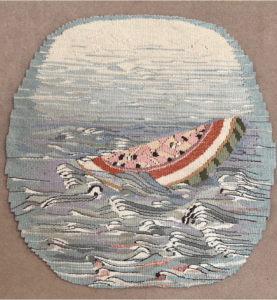Opening Friday, May 6
First Friday Gallery: June 3
Pacific Textile Arts May 6 – June 30, 2022
during regular gallery hours
Jackie Wollenberg
Celebrating a Weaver’s Journey
A Retrospective

I bought my first small four harness floor loom after discovering it sitting out in the courtyard of a friend. I learned some very basic skills after taking the loom to the “Redbug Gallery”, a little shop on College Avenue in Berkeley. Not long after that, my husband was invited to do some work in Denmark where we moved with our three children. In Denmark, a kind and thoughtful wife of one of my husband’s colleagues loaned me a loom for the two years we stayed there. I soon learned that there was a weaving teacher I could study with at the Lejre Historical Archaeological Research Center near where we were living. However, she would not deal with me unless I learned enough Danish to hold a phone conversation
in her language because she didn’t speak a word of English. So, I drove shop keepers, neighbors and night school teachers crazy until I could speak on the phone with Nina Ratche.
When I was finally accepted, I soon found myself walking in the woods hunting for pieces of limbs of trees with which to build a version of a warp weighted loom according to Nina’s descriptions of looms from the Bronze and Iron ages. While at Nina’s studio I learned how to make a warp for my newly crafted loom with a card woven band. I soon learned to prepare and spin wool from the sheep she kept nearby and sometimes within her studio. Nina taught us how to create examples of clothing worn by people buried in Danish bogs. Some of these replicas were made for the National Museum in Copenhagen. I learned to make all kinds of braids, including Slentra bands as well as to dye yarn with local plant material. I also learned to do Sprang, a continuous warp method of making lace-like fabric.
After returning home, I was fortunate to join a weaving class taught by Kay Sekimachi in San Francisco. I learned so much of value from Kay about her ways of doing things such as warping the loom from the back, reading and creating drafts and drawdowns. A few years later I was part of the last graduate design class Ed Rossbach taught at my old UC Berkeley alma mater. By that time my children were teenagers and I remember doing an all nighter with one of my boys who was attending Cal at the same time. I couldn’t have done any of this without the help and support of my family, especially my children and husband, Skip.
 During my explorations of what the loom can produce, I was particularly drawn to the possibilities of working with supplementary warps. I can remember weaving different patterns in that mode while moving from one variation to another and listening to some wonderful Bach patterns and variations. In this period I was teaching the Berkeley Adult School weaving class and attending graduate school where I became obsessed with photography and the dark room. Along the way I took a turn learning about tapestry at the San Francisco Tapestry Workshop under the guidance of Jean Pierre Larochette. Our familiy eventually became good friends with the Larochettes. Skip and I traveled with them to France, Patagonia in Argentina and Chile. Jean Pierre and Yael eventually introduced me and other lucky weavers to tapestry weaving in Mexico. We were invited to retreats at their studio in El Tuito, an hour’s drive from Puerto Vallarta. Eventually we were invited to show our work at the Textile Museum in Oaxaca.
During my explorations of what the loom can produce, I was particularly drawn to the possibilities of working with supplementary warps. I can remember weaving different patterns in that mode while moving from one variation to another and listening to some wonderful Bach patterns and variations. In this period I was teaching the Berkeley Adult School weaving class and attending graduate school where I became obsessed with photography and the dark room. Along the way I took a turn learning about tapestry at the San Francisco Tapestry Workshop under the guidance of Jean Pierre Larochette. Our familiy eventually became good friends with the Larochettes. Skip and I traveled with them to France, Patagonia in Argentina and Chile. Jean Pierre and Yael eventually introduced me and other lucky weavers to tapestry weaving in Mexico. We were invited to retreats at their studio in El Tuito, an hour’s drive from Puerto Vallarta. Eventually we were invited to show our work at the Textile Museum in Oaxaca.
During that same period, I became fond of a Japanese method of braiding called Kumihimo. Some of us traveled to Japan with Shozo Sato and studied with Makiko Tada who has come to the Henhouse Studio in Fort Bragg to do Kumihimo with us. In the early nineties we moved to Fort Bragg where I took part in the formation of Pacific Textile Arts. Our small group of active textile artists became the recipient of the non-profit status originally held by Pacific Basin School of Textile Arts in Berkeley where I had earlier been on the board and faculty. I feel fortunate to have worked with so many wonderful fellow weavers during my travels for Convergence, CNCH and guild workshops. It has been my pleasure to have exhibited in the U.S., Canada and Mexico.
Many thanks to:
Karen Inwood, Jenny Bloomfieldm Art Morley, Kay Sekimachi, Sachiyo Aoyama, Juanita Neilands, Yael Lurie, Elaine Todd, Laine Escola, Skip Wollenberg, Kathy Wollenberg, Chuck Wollenberg, Mike Wollenberg, Steve Wollenberg, Susan Wollenberg, Jean Pierre larochette, Suren Holbek, Sandra Lindstrom, Larry Wagner, Lolli Jacobsen, Joanie Packard, Suzanne da Rosa, Nancy Denison, Norma Lee Andres, Jennie Henderson, Nancy Trissel, Rodrick Owen, Michael Hattorri, Makiko Tada, Richard Sutherland ,Linda and John Turner, Leah Wollenberg, Larkin O’Shea, Mira Wollenberg, Elena O’Shea, and many Others
